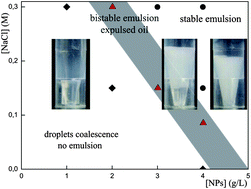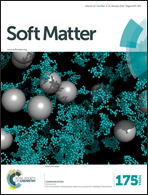Aging mechanism in model Pickering emulsion†
Abstract
We study the stability of a model Pickering emulsion system using fluorinated oil and functionalized silica nanoparticles. A special counter-flow microfluidic set-up was used to prepare monodisperse oil droplets in water. The wettability of the monodisperse silica nanoparticles (NPs) could be tuned by surface grafting and the surface coverage of the droplets was controlled using the microfluidic setup. For surface coverage as low as 23%, we observed a regime of Pickering emulsion stability where the surface coverage of emulsion droplets of constant size increases with time, coexisting with an excess of oil phase. Our results demonstrate that the previously observed limited coalescence regime where surface coverage tends to control the average size of the final droplets must be put in a broader perspective.


 Please wait while we load your content...
Please wait while we load your content...